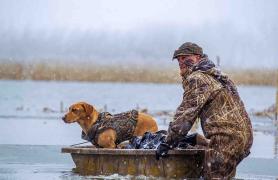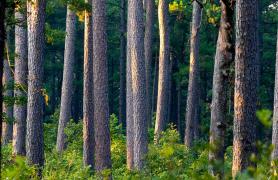Give Your Rake a Break
Did you know deciduous trees absorb their leaves’ nutrients before shedding them each fall? This is key to their survival and economical for the tree — similar to a human using up the food in their refrigerator before it expires. Rest assured, those fallen leaves don’t go to waste. Fallen leaves:
- Nourish the soil.
- Create a mulch layer that helps rain and snow soak into the ground.
- Provide refuge and food for backyard wildlife, including insects, birds, butterflies, and other pollinators.
For these reasons, it’s best to drop that rake, and let those leaves fall where they may.
Time to Get the Winter Coat
As the winter temperatures set in, we, as humans, pull out our winter coats. Mammals in the wild are not much different. Take a look at the eastern gray squirrel. In winter, the squirrel’s fur becomes longer and more silvery gray and the ears have a noticeable projecting fringe of white fur.
Similarly, in white-tailed deer, the color pattern of the winter coat is grayish to grayish brown — not reddish brown to tan — and this is often called the blue coat. The hairs of the back are blacker tipped, giving a darker appearance to the back, but the black chin patch is less sharply defined. The hairs of this coat are long and heavy; each hair has many air spaces that act as insulators, helping to insure warmth during cold weather. The coat easily repels cold rain and wet snow in winter.
Battle Bush Honeysuckle
If your plan to rake leaves has been circumvented (see Give Your Rake a Break) and now you have pent-up yard work energy, turn it toward battling bush honeysuckle. After most of the fall color is gone, you may see some green remaining in the forest understory. Exotic invasive bush honeysuckle will remain green well into December, making it easy to spot. Bush honeysuckle stays green after most plants have gone dormant, and in spring greens up before other species leaf out, and then grows so aggressively, outcompeting our native wildflowers and other plants, preventing regeneration of our forests. Get out and help control this problematic shrub. Find out how by visiting short.mdc.mo.gov/ZCi.
Get the Feeders Ready
As cold weather sets in and natural food sources dwindle, backyard birds will be seeking food. It’s time to put up bird-feeding stations. Common winter backyard birds to look for, to name just a few, include:
- American goldfinch
- Black-capped chickadee
- Carolina chickadee
- Dark-eyed junco
- Blue jay.
Enjoy more time hunting
Go mobile with the MO Hunting app. Purchase, view, and store permits. Notch your permit and telecheck your deer and turkey harvest. Access basic statewide regulations, season information, and more.
Download the free app today at mdc.mo.gov/mohunting
Natural Events to See This Month
Here’s what’s going on in the natural world.
- Eastern witch-hazel flowers.
- Oyster mushrooms fruit year-round.
- Voles and mice are active, creating tunnels under the snow.
Also In This Issue

These hunters and dogs team up for successful harvests

Restoring a former foundation of the Ozark forest
And More...
This Issue's Staff
Editor - Angie Daly Morfeld
Associate Editor - Larry Archer
Photography Editor - Cliff White
Staff Writer - Kristie Hilgedick
Staff Writer - Joe Jerek
Staff Writer – Dianne Van Dien
Designer - Shawn Carey
Designer - Marci Porter
Photographer - Noppadol Paothong
Photographer - David Stonner
Circulation Manager - Laura Scheuler






















